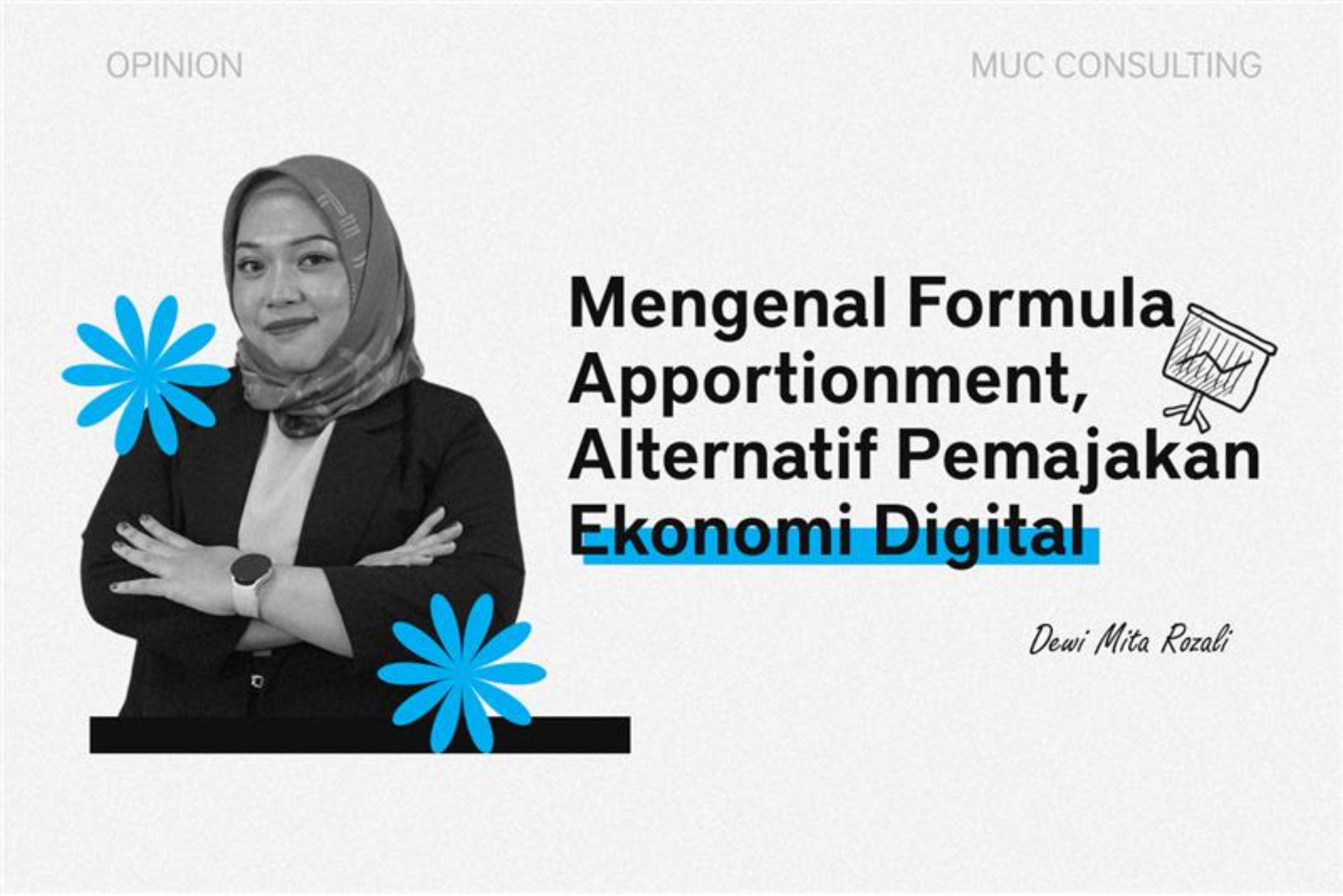Understanding Formula Apportionment, an Alternative for Taxing the Digital Economy

The efforts of countries around the world to share taxing rights over the income of digital companies remain far from fruition. Their collective move to build a consensus on allocating taxing rights to those countries faces considerable challenges.
One of the challenges is the lack of unanimous agreement among countries to endorse the draft Multilateral Convention (MLC) Amount A under Pillar 1, which concerns the allocation of taxing rights.
Initiated in 2016, the drafting of the taxing rights allocation concept under Pillar 1 has yet to be completed. In general, Pillar 1 provisions consist of two components: Amount A and Amount B.
Major countries such as the United States are reportedly among the reasons for the deadlock in Pillar 1 discussions. The slow resolution of Pillar 1 is seen as prolonging global uncertainty in addressing the growth trend of the digital economy worldwide.
As we know, the digitalization of the economy has created challenges, particularly in the tax context. Conventional taxation practices have lost relevance when faced with business models that no longer require a physical presence to sell goods and services.
Redefining Permanent Establishment
Under conventional tax practices, a company can only be taxed on its income in a country if it has a physical presence there—for example, by opening a branch office, a marketing office, or establishing a Permanent Establishment (PE).
In the digital economy era, however, a multinational enterprise (MNE) can market its products without any physical presence, such as what U.S.-based digital giants like Google, Facebook, Amazon, and Apple do.
This clearly conflicts with the principle under international tax treaties that requires a physical presence to tax profits generated.
On the other hand, the profits earned by such companies are often unrelated to any physical presence in the market where they sell products or services digitally. Therefore, the OECD has proposed the establishment of a digital PE that covers concepts such as Virtual Fixed Place, Virtual Agency PE, and On-site Business Presence.
In this case, a country could be deemed to have a PE if a company operates and conducts business through a particular website. The company’s virtual website could be regarded as a “place of business” for PE purposes.
Furthermore, the definition of a dependent agent could be expanded so that if a website or application routinely completes transactions binding the company to customers in a particular country, the website could be deemed an agent and thus create a PE in that country, regardless of the physical location of the server hosting the website.
In addition to redefining PE, the OECD has also proposed using Formula Apportionment to allocate profits to market jurisdictions based on certain factors as part of broader digital tax reform.
Applied in the United States, Proposed by the OECD
In fact, a simpler form of the Amount A provision under Pillar 1, which concerns the allocation of global taxing rights, is found in a concept known as Formula Apportionment.
Ironically, although the United States is among the countries that have yet to agree to sign the Pillar 1 Multilateral Instrument (MLI), it is the U.S. itself that pioneered the tax allocation scheme called Formula Apportionment. However, in the U.S., the context of Formula Apportionment is not specifically for digital taxation, but rather as a mechanism for allocating taxing rights among individual states.
In that system, the ratio used to allocate income among states is based on payroll, assets, and sales, with weighting applied to these factors.
From the concept developed in the U.S., the OECD then adopted Formula Apportionment for determining digital taxing rights. The difference is that the OECD uses non-physical factors as the basis for allocation, such as the volume of sales, user data, or the number of digital interactions.
The goal is to ensure that countries where consumers or users are located obtain a greater share of taxing rights, even without the physical presence of the company.
Another country that applies Formula Apportionment is Canada. Its implementation uses a two-factor formula, giving equal weight to employee payroll costs and sales to allocate income among its provinces.
Implementation of Formula Apportionment in the United States
The United States implements Formula Apportionment by determining the taxable profits of companies in 45 states. This is done by calculating the federal tax base and making the necessary adjustments.
Initially, the factors were weighted equally. However, in recent years, most states have given half-weight to sales.
Here is an illustration of how Formula Apportionment is applied in the U.S.:
Suppose a company operates in three U.S. states, California, New York, and Texas, and has global revenue of USD 100 million.
1. Determining Payroll, Sales, and Assets
The first step is to determine the amount of payroll, sales, and assets in each state. The factors used to determine each state’s share of taxable income are:
1. Payroll: Total wages paid to employees in each state.
2. Sales: Total sales made in each state.
3. Assets: Total value of assets owned in each state.
|
US States |
Payroll |
Sales |
Asset |
|
California |
$ 2 million |
$10 million |
$ 5 million |
|
New York |
$ 3 million |
$ 25 million |
$ 10 million |
|
Texas |
$ 1 million |
$ 15 million |
$ 2 million |
|
Total |
$ 6 million |
$ 50 million |
$ 17 million |
2. Calculating Factor Ratios in Each State
|
US States |
Payroll Ratio |
Sales Ratio |
Asset Ratio |
|
California |
33,33% ($2M/$6M) |
20% ($10M/$50M) |
29,41% ($5M/$17M) |
|
New York |
50% ($3M/$6M) |
50% ($25M/$50M) |
58,82% ($10M/$17M) |
|
Texas |
16,67% ($1M/$6M) |
30% ($15M/$50M) |
11,76% ($2M/$17M) |
|
Total |
$ 6 M |
$ 50 M |
$ 17 M |
3. Calculating Weighted Factors
Next, the following step is to calculate the weighting of each factor using equal weights or based on the preferences of the state that adopts the formula apportionment.
For example, if a state uses a three-factor apportionment that gives equal weight to payroll, sales, and assets, then each factor will weigh 1/3. The allocated profit value can then be calculated from the total weight of these three factors.
Below is the calculation of the weights and profit allocation for each state.
|
Negara Bagian AS |
Bobot Payroll |
Bobot Penjualan |
Bobot Aset |
Alokasi Laba |
|
California |
11,11% (33,33% x 1/3) |
6,67% (20% x 1/3) |
9,80% (29,41% x 1/3) |
27,58% (11,11%+6,67%+9,80%) |
|
New York |
16,67% (50% x 1/3) |
16,67% (50% x 1/3) |
19,61% (58,82% x 1/3) |
52,94% (16,67%+16,67%+19,61%) |
|
Texas |
5,56% (16,67% x 1/3) |
10% (30% x 1/3) |
3,92% (11,76% x 1/3) |
19,48% (5,56%+10%+3,92%) |
4. Calculating Tax Based on Rates
The final step is to calculate the tax imposed based on each state's tax rate. For example, California's tax rate is 8.84%, New York's tax rate is 6.5%, and Texas's tax rate is 0.375%. Therefore, the tax payable by the company in each state is as follows:
|
US States |
Tax Payable |
|
California |
$2,44 Million (27,58% x $100 M x 8,84%) |
|
New York |
$3,33 Million (52,94% x $100M x 6,5%) |
|
Texas |
$73.050 Million (19,48% x $100Mx 0,375%) |
Mutual Agreement is The Key
In essence, the implementation of Formula Apportionment can have a positive impact, not only for countries or jurisdictions in terms of revenue but also for companies.
This is especially true when applying the Arm’s Length Principle (ALP) in transfer pricing. While this concept cannot replace the ALP, it can complement it, particularly in identifying functions, assets, and risks that are difficult to assess in digital transactions. However, the use of Formula Apportionment is not without its drawbacks.
A key concern in using Formula Apportionment is the emergence of double taxation risks and uncertainty. These arise due to the lack of uniformity in tax systems across different countries. Therefore, the implementation of Formula Apportionment must be accompanied by a global commitment; in other words, it must be achieved through consensus.
Another challenge in implementing Formula Apportionment lies in data accuracy, especially geographical sales data and user data. Inaccuracies in this data can make it difficult to determine appropriate weightings for factors such as sales volume, user data, or the number of digital interactions.
So, in the end, as long as there is no agreement among countries, it will be difficult to fairly distribute taxing rights. Yet, considering the current intense global political and economic dynamics, can such a consensus ever truly be reached?
Source: OECD. (2011). Tax Policy Studies: E-commerce: Transfer pricing and business profits taxation. OECD Publishing.
Disclaimer! This article is a personal opinion and does not reflect the policies of the institution where the author works.


